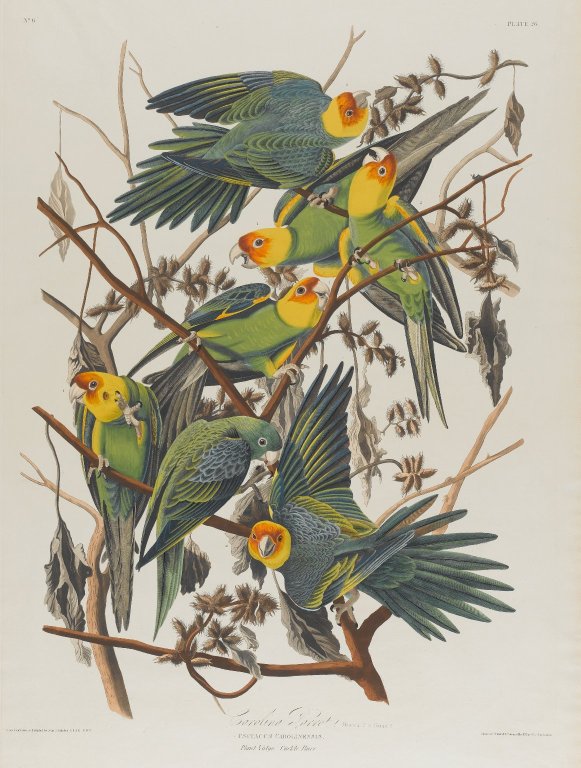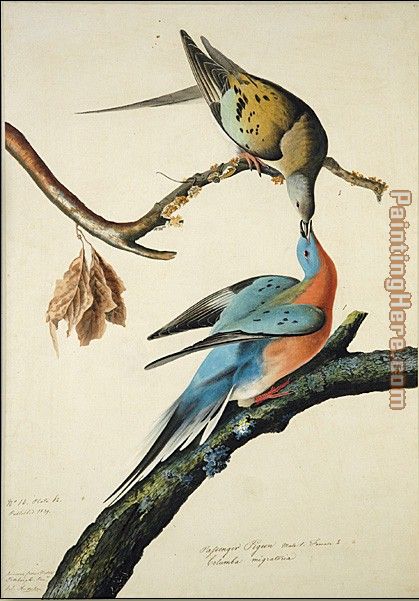Sunday, November 25, 2012
Audubon’s Dream Realized: Selections from "The Birds of America"
John James Audubon (1785–1851) combined his love of nature with his artistic talent to produce some of the most beautiful and lifelike depictions of birds ever created. The exhibition Audubon’s Dream Realized: Selections from "The Birds of America", on view from September 25, 2005 through March 26, 2006 at the National Gallery of Art, featured the superb oil painting
Osprey and Weakfish (1829), a recent gift to the Gallery from Richard Mellon Scaife.
Also on display were 50 of the artist’s hand-colored etchings selected from the Gallery’s early edition of the publication, "The Birds of America" (1826–1838). One of only two known complete sets preserved in their original, unbound state, the prints were given to the Gallery in 1945 by Mrs. Walter B. James.
Audubon’s dream of recording every native American bird consumed nearly 20 years of his life and was realized with the publication of a mammoth edition of 435 hand-colored etchings, all based on his vivid life-size watercolors. Some of the set’s most celebrated and outstanding prints will be on view, including American Flamingo (1838), Carolina Parrot (1827), and Ivory-billed Woodpecker (1829), an image of a species thought to be extinct until its recent reported sighting in Arkansas.
The Exhibition
John James Audubon (1785–1851) was a prolific artist who copied many of his bird drawings in oil paint, yet fewer than 70 of his oil paintings are known to have survived. On view in the exhibition, the recent gift to the Gallery of Osprey and Weakfish (1829) is an exceptionally fine example which Audubon kept in his own collection throughout his life. Audubon’s image of the osprey derives from his observations of it in Great Egg Harbor, New Jersey, in June 1829, and clearly conveys his admiration of the bird’s strength, beauty, and agility.
The prints on view in the exhibition were selected from the National Gallery of Art’s early edition of "The Birds of America". Audubon’s double-elephant folio—a standard term of measurement for the largest sheet of paper produced in the 19th century, approximately 39 1/2 x 261/2 inches—consists of 1,065 images of birds and represents 449 different species. The publication was a technical marvel, and its success was the result of a close collaboration between the artist and London printer Robert Havell, Jr. (1793–1878).
A largely self-taught artist and ornithologist, Audubon is credited with being the first artist to successfully portray birds in their natural habitats. He not only painstakingly noted the behavior of species in their environments, but also drew from specimens he shot and preserved to use as models. He devised a method of inserting thin wires into the bodies of freshly-killed birds, allowing him to position them in dramatic and lifelike poses. This process—along with his vivid use of color and depiction of natural settings—enhanced the emotional impact of his images.
One of the most striking images in the exhibition was American Flamingo (1838), a species Audubon first saw in the Florida Keys but was unable to collect. Although ultimately drawn from a specimen sent to him in London, Audubon brilliantly exploited the entirety of the sheet’s dimensions to capture the expansive size and graceful pose of this magnificent bird.
Among the exhibition’s highlights was Goshawk and Stanley Hawk (1832), particularly interesting because it reveals Audubon’s development as an artist: the two hawks on the bottom were drawn in 1809 while the hawk at the top was drawn around 1829.
Attribution: www.RestoredPrints.com
Audubon did not always portray birds in tranquil moments. Virginian Partridge (1830), for example, depicts 18 bobwhites being attacked by a young red-shouldered hawk.
Another dramatic image is The Mocking Bird (1827), which shows four birds protecting their nest of eggs against a rattlesnake. The birds’ vivid expressions and gestures were criticized as unnatural by many of Audubon’s rivals. It was also wrongly thought at the time that rattlesnakes neither climbed trees nor had the curved fangs visible in the print.
Other celebrated images on view were Carolina Parrot (1827)
and Passenger Pigeon (1829), both of which portray birds that are now extinct.
Also included was the Ivory-billed Woodpecker (1829), one of the largest and most dazzling of the woodpeckers, which, until its recent reported sighting in Arkansas, was believed to be extinct. Audubon, a skilled and enthusiastic hunter, was in later years aware of the need for environmental conservation and protection of America’s endangered wildlife and vanishing wilderness—a cause that is synonymous with Audubon’s name today.
Artist’s Biography
Born in Saint-Domingue (now Haiti) in 1785, Audubon was the son of a French naval officer and his mistress. His mother died within a year of his birth, and he was raised in Nantes, France, by his father and stepmother. They sent him to America when he was eighteen, both to manage the family estate near Philadelphia and avoid conscription in Napoleon’s army. After a brief return to France, Audubon settled in the United States and eventually became an American citizen. In 1808, he married Lucy Bakewell, and together they had two sons.
Over the next decade, Audubon was involved in one unsuccessful business venture after another, while devoting his spare time to drawing birds. Bankrupted in 1819, he turned to his talents as an artist and began doing chalk and pencil portraits, and worked parttime as a taxidermist in Cincinnati. It was then that he reassessed his life and resolved to dedicate himself to the study of American birds and the publication of "The Birds of America". With that goal in mind, he set out for the woodlands of Louisiana on the first of several arduous expeditions through the American wilderness in search of birds.
Unable to secure financial support or a suitable printer for his project in the United States, Audubon sailed for England in 1826. Locating someone willing to commit to a publication that by conservative estimates would take more than a decade to complete was not easy. Ultimately it was the London printer Robert Havell Jr. who was primarily responsible for the completion of the set of illustrations. He worked assiduously over the course of a decade to reproduce Audubon’s watercolors as life-size etchings, which were then hand-painted by a team of colorists.
In addition to difficult and lengthy excursions throughout much of America, Audubon made regular trips to London to supervise the etching and coloring of his prints. By the time the book was completed in 1838, Audubon had won critical acclaim on both sides of the Atlantic for his sensitivity to both scientific illustration and fine art. He continued to study birds and other wildlife, but by 1846, his failing eyesight and diminished mental state prevented him from working, and on January 17, 1851, Audubon died at his home along the Hudson River in New York.




.jpg)



